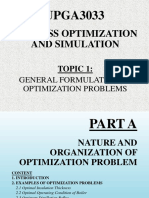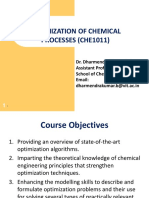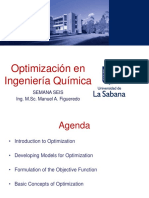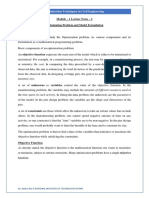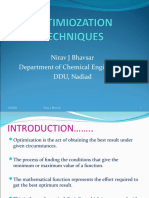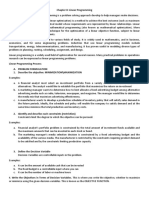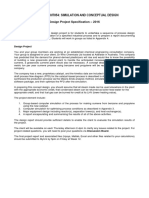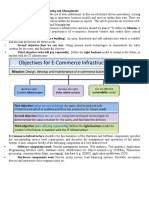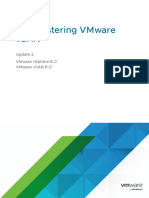Chapter 1
Optimization problems
�What is optimization problem?
Optimization is the use of specific methods to determine
the most costeffective and efficient solution to a problem
or design for a process
For design, optimization is used for the largest
production, the greatest profit, the minimum cost, the
least energy usage, and so on.
For plant operations, optimization is applied to improve
yields of valuable products, reduce of energy
consumption and maintenance costs, higher processing
rates, longer times between shutdowns
�Example 1
Insulation of
thickness ,
Hot fluid,
Air
Cost $
Optimal insulation thickness. The addition of insulation
should save money through reduced heat losses; on the
other hand, the insulation material can be expensive. The
amount of added insulation needed can be determined by
optimization.
Heat loss
insulation thickness
�Fixed cost
Example 2
Column
Recycle
Feed
Reactor
conversion
Product
Cheaper reactor, lower conversion, then higher separation cost
Expensive reactor, higher conversion, then lower separation cost
�Hierarchy of levels of optimization
Management
Allocation &
Scheduling
Design
Individual
equipment
Project evaluation
Product selection
Corporate budget
Investment
Operations
Carry out monthly, weekly
Plant operating controls
Shipping, transportation,
product distribution
Maintenance schedule
Choice of process
Operating conditions
Configuration of the plant
Process arrangement
Optimum design
�Popular problems in optimization
1
Cost minimization
Profit maximization
Schedule optimization
Process improvement: efficiency, yields, selection
Environment effects improvement
�Optimization problems in Chemical Eng.
1
Determining the best sites for plant location
Routing tankers for the distribution of materials and products
Sizing and layout of a pipeline
Design equipment and an entire plant
Scheduling maintenance and equipment replacement
�Optimization problems in Chemical Eng.
6
Operating equipment: tubular reactors, columns, absorbers
Evaluating plant data to construct a model of a process
Minimizing inventory charges
Allocating resources or services among several processes
10
Planning and scheduling construction
�Key problem of optimization
You must be able to translate a verbal
statement or concept of the desired
objective into mathematical terms
�The features of optimization problems
Optimization problems are described in mathematical form:
The objective function (economic criterion)
The constraints (the process model)
The objective function represents such factors as profit,
cost, energy, and yield in terms of the key variables of the
process being analyzed
The constraints describe the interrelationships of the key
variables such as mass & energy conservation, empirical
relations in equality or inequality forms
�The features of optimization problems
Optimization problems are described in mathematical form:
Minimize:
Subject to: = 0
0
objective function
equality constraints
inequality constraints
where is a vector of variables 1 , 2 , ,
is a vector of equations of dimension 1
is a vector of inequalities of dimension 2
the total number of constraints is = 1 + 2
�The features of optimization problems
A feasible solution of the optimization problem is a set of
variables that satisfy the constraints
An optimal solution is a set of values of the variables that
satisfy the constraints and provide an optimal value for the
objective function (maybe one or more)
�Example 3
2 =?
1 = 170
= 500
= 1
=?
=?
Unit price of water:
Overall heat transfer coefficient:
Operating cost conversion:
= 10
Capital cost $ : 0.484
2 = 80
1 = 25
=?
= 4.2
Design a shelltube with minimum cost
�Example 3
Variables: , , , 2
1
2
, , , 2 0
Constraints:
1 2 10
1
Objective function: = 0.484 +
�Example 3
Develop the process model
= 1 2
= 2 1
1 2 2 1
=
1 2
ln
2 1
�Example 3
Optimization problem is minimization of
= 0.484 +
The constraints:
equalities
1 : 1 2 = 0
2 : 2 1 = 0
1 2 2 1
3 :
=0
2
ln 1
2 1
:
10
inequalities 1 :1 , ,2 , 0
25
2
�Classification of optimization problems
1
One or Many objectives
Unconstrained vs Constrained optimization
Continuous vs Discrete optimization
Linear vs nonlinear optimization
�Classification of optimization problems
5
Lumped vs Distributed optimization (space)
Steady vs Unsteady optimization (time)
Deterministic vs Stochastic optimization (error)
�Degrees of freedom
=0
For the constraints as
0
where is a vector of variables 1 , 2 , ,
the number of equality constraints (for industry) is
There is only one root, simulation problems
= = 0
There are more than one root, optimization problems
= > 0
Normally, inequality constraints dont affect the
�Example 4
Examine the following optimization problem. State the total
number of variables, number of independent variables and
Minimize:
= 41 22 12
Subject to:
25 12 22 = 0
101 12 + 102 22 34 0
1 3 2 + 2 1 2 0
1 , 2 0
�Size of optimization problems
< 100
, small size problems
< 500
< 400
, medium size problems
< 1000
+ > 106 , large size problems
�General procedure for solving
optimization problems
Analyze the process and define the process
variables
Determine the criterion for optimization and
specify the objective function with coefficients
Develop the process model including both
equality and inequality constraints. ?
�General procedure for solving
optimization problems
If the problem is too large: (a) simplify the
objective function and model, (b) break it up
Apply a suitable optimization technique to
solve the problem
Examine the sensitive of the results to
changes in the coefficients in the problem
�Constraints formulation
The constraints describe the physical bounds of the
variables, empirical relations, physical and chemical laws
(mass and energy balances, thermodynamics, chemical
reaction kinetics, physiochemical models)
Mathematical models are employed in all areas of science,
engineering, business, equipment design, interpret data,
and so on.
�General procedure for
constraints formulation
Experience,
reality
Formulate model objectives, evaluation
criteria, costs of development
Management
objectives
Select key variables, physical principles
to be applied, test plan to be used
Problem definition
phase
Computer simulation,
software development
Develop model
Estimate parameters
Observations, data
Design phase
Evaluate and verify model
Apply model
Evaluation phase
�The categories of formulation
Algebraic equations
Systematical models
(physical theory)
Integral equations
Differential equations
Formulation
Linear equations
Exponential equations
Empirical models
(empirical data, blackbox)
Logarithmic equations
Polynomial equations
Power equations
Rational equations
Difference equations
�Example 5
Build a linear empirical model from the experimental data as
shown below:
Experiment
number
�Example 5
Form of linear empirical model: =
=1
unknown
coefficients
Application of linear least square
for coefficients determination
=
=1
=1
Normally,
�Example 5
1 , 2 , , is estimated by necessary condition:
=0
1
=0
2
=0
�Example 5
1 , 2 , , is estimated by necessary condition:
1 1 1 + 2 1 2 + + 1 = 1
=1
=1
=1
=1
1 2 1 + 2 2 2 + + 2 = 2
=1
=1
=1
=1
1 1 + 2 2 + + =
=1
=1
=1
=1
�Example 5
Vectors definition:
1
2
=
11
21
=
Then, =
12
22
1
2
1
2
=




